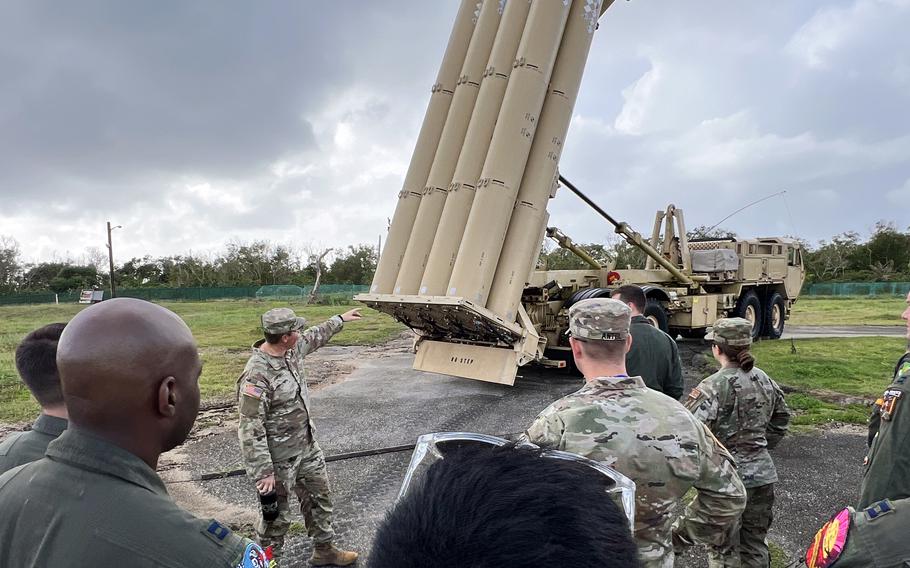
U.S. Army Capt. Riley Campbell points out the components of the Terminal High Altitude Area Defense, or THAAD, system to airmen visiting the battery in Guam on Feb. 23, 2024. (Stephen Collier/U.S. Air Force)
The Army branch responsible for bringing new technology quickly into the U.S. arsenal is now tasked with creating an integrated missile defense system on Guam, a need the Indo-Pacific commander classified as paramount.
The U.S. Army’s Rapid Capabilities and Critical Technologies Office will lead the effort through its Guam Defense Systems Joint Project Office, which was stood up on Feb. 2.
Personnel for the joint project will be drawn from the various military services and the Missile Defense Agency, Lt. Gen. Robert Rasch, director of the Rapid Capabilities and Critical Technologies Office, said by phone April 12 from his headquarters at Redstone Arsenal, Ala.
The Joint Project Office team is expected to grow to 86 personnel over the next year, he said.
“Although my office has been chosen as the lead, it is a joint effort involving the various services and agencies,” Rasch said.
“The Missile Defense Agency has been helping lead this effort for a couple of years,” he said. “We’re leveraging a lot of their work, and that will be a significant contribution to this effort going forward.”
Top homeland defense priority
The head of U.S. Indo-Pacific Command regards Guam’s comprehensive missile defense as urgent, given China’s growing military might and the threat long posed by North Korea.
“As the most forward U.S. territory in the Western Pacific, Guam is a strategic outpost critical to projecting power, maintaining deterrence and stability, and responding to regional crises or conflicts,” Adm. John Aquilino said in written testimony during a March 18 hearing of the House Armed Services Committee.
“Establishing the [Guam Defense System] — a 360-degree, persistent, layered, and integrated air and missile defense on Guam — remains the top homeland defense priority for USINDOPACOM to protect more than 170,000 U.S. citizens on the island,” he said.
Guam’s current missile defense capabilities include an Army Terminal High Altitude Area Defense, or THAAD, battery, with additional defense provided by U.S. Navy warships equipped with the Aegis Combat System and deployed as-needed to the region, according to an Aug. 3 report by the Congressional Research Service.
The THAAD and Aegis systems are not integrated and rely on separate sensors and command-and-control systems, the report states.
Missile Defense Agency documents have projected Guam’s new missile defense architecture would demonstrate “initial capability” this year, “enhanced capability” in 2029 and then undergo further development in the 2030s, the CRS report states.
In March, Aquilino described that timeline as “late to need” and urged accelerated operations and funding to complete the defense system this decade.
Rasch said the Rapid Capabilities and Critical Technologies Office, or RCCTO, is a “natural fit” for streamlining the Guam Defense System’s deployment because the office’s purpose is to speedily develop, prototype, test and bring to the field emerging technologies.
Pressure to produce
The foremost challenge facing the Joint Project Office will be what Rasch called “thickening the sensor layer.”
That means aligning and integrating different sensors used by Army, Navy and MDA defense systems “so that we don’t have redundancy of information being reported and that each sensor is reporting on the same thing in the same way,” Rasch said.
“It’s not a new problem,” he said. “It’s a problem that the services have kind of tackled on their own in the past. Now we’ve got to roll that in at the joint level and make sure that we have a consistent way of going through that detection-classification-discrimination process.
“The underlying technologies are there. Now we just have to make sure that we put it together in a way to get the absolute best effectiveness of those capabilities that we bring onto Guam.”
The project team will validate the defense architecture through modeling and simulation, live-fire exercises and operational assessments by the service members operating the system components, Rasch said.
RCCTO is awaiting funding for the project team that was included in the fiscal 2024 spending bill approved by Congress only a few weeks ago.
“We’ve already set up a small team here, trying to get ahead of that so that when we get the resources we can move very, very rapidly,” said Rasch, adding that it was “a little premature” to offer up a timeline for the project.
“There’s a pressure to go as quickly as possible, and we acknowledge that, and we’re going to do exactly that,” he said.